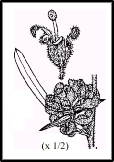South West Slopes Revegetation Guide
Grevillea polybractea
Crimson Grevillea
Select from the following for detailed images.
Species Information
| Synonyms |
|
| Common Names |
Crimson Grevillea |
| Family |
Proteaceae - Protea family. |
| Name Origin |
Grevillea - after Charles Francis Greville (1749-1809), co-founder of London Horticultural Society. polybractea - from Greek poly, many, and Latin bractea, bract, referring to many bracts which conceal buds. |
Specimen Data -
| Location |
|
| Notes |
No Specimen Data Available |
| Collector |
|
Date |
01/09/1997 |
| Determined By |
|
Date |
01/09/1997 |
South West Slopes Revegetation Guide Information
| Regional: |
Noted in eastern parts of the region, including the areas: Upper Back-Upper Jerra Jerra; Yarra Yarra; Coreinbob; O'Briens South & McLeods; Upper Kyeamba; Keajura; Upper Burkes; Major; Murraguldrie and Carabost. |
| Australia: |
NSW, Vic. |
| Habitat: |
Dry sclerophyll forest on granite soil. |
| Habit: |
Dry sclerophyll forest on granite soil. |
| Similar Species: |
|
| Site Preference: |
|
| Characteristics: |
Prone to root-rot fungus and quickly dies if infected. Hybridises with Woolly Grevillea (G. lanigera) and Rosemary Grevillea (G. rosmarinifolia). |
| Flowering: |
Red to pink with yellow or green, spring. Dense woolly flowerheads. |
| Seed Collection: |
Summer. Monitor closely, as seeds shed soon after maturity. Secure nylon stockings or paper bags to fruiting branches after flowering to ensure collection. |
| Propagation: |
From cuttings, which strike readily. Can be grafted onto Rosemary Grevillea. |
| Regeneration: |
|
| Timber: |
|
| Shade and Shelter: |
Useful low-level cover in windbreaks. |
| Land Protection: |
|
| Wildlife: |
Good habitat. |
| Ornamental: |
Attractive. Interesting well-displayed flowers. Excellent in tubs. Prune from early age to retain low growth. Avoid excess watering. |
| Other: |
|
Note: The following information presented is only a guide, as plant characteristics vary depending on provenance (the plant's locality).
| Site/Preferred Habitat : |
well-drained soil, slightly sheltered areas |
| Rainfall(mm) : |
400+ |
| Growth Rate : |
|
| Tolerates : |
full sun; moderate frost. |
| Resents : |
root-rot fungus |
| Uses & Comments : |
ornamental; wildlife |
Return to Database List
